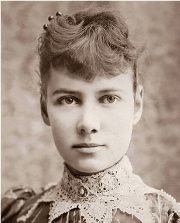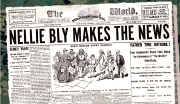E-Archive
Off the Beaten Track
in Vol. 22 - March Issue - Year 2021
What Girls Are Good For


I have never written a word that did not come from my heart. And I never shall.
*****
Elizabeth Jane Cochran was born on May 5th 1864 in a village not far from Pittsburgh. Her father died when she was six, putting her mother and four siblings in a dire financial situation as he left them without a will. At the age of fifteen, she enrolled at a small college in Pennsylvania, but was forced to quit after one term because she could not afford the tuition fees. A year later, Elizabeth’s mother moved the family to Pittsburgh, where they ran a boarding house. A bright and vivacious girl, Elizabeth was an avid reader and combed the daily newspapers.
In 1882 the Pittsburgh Dispatch published an editorial entitled “What Girls Are Good For”. The author argued that women are good only for raising children and for domestic chores, calling the working woman “a monstrosity”. Elizabeth wrote a fiercely indignant rebuttal under the pseudonym “Lonely Orphan Girl” that caught the attention of the paper’s managing editor. He placed an advertisement asking the anonymous writer to make her identity known. When Elizabeth stepped forward, the editor suggested that she write an article for the newspaper under the same pseudonym. Elizabeth produced a piece entitled “The Girl Puzzle” in which she examined how divorce affected women and proposing reform of divorce laws. The article was very well received by readers and prompted the editor to offer Elizabeth a full-time job as a reporter. Her starting salary was $5.00 per week. Female journalists were not readily accepted in those years, so the editor chose a pen name for Elizabeth, who from that moment became known as Nellie Bly, after a character in a famous song. All of this happened when Elizabeth was only eighteen years old.
In a series of articles for the Pittsburgh Dispatch, Nellie Bly wrote about women factory workers, the exploitation of underage laborers, and the lack of adequate health and safety regulations in workplaces. She once posed as a sweatshop worker to uncover poor working conditions. When the state of Pennsylvania announced changes in its marriage and divorce laws that would have limited women’s liberties, Nellie Bly ran a series of interviews with divorced women. She was one of the few journalists to interview Belva Ann Lockwood, the first female U.S. presidential candidate.
Nellie’s articles irritated factory owners and big capitalists, who pressured the newspaper to reassign her to the “women’s pages” covering fashion, gardening and social gossip. Very unhappy with her new role, at the age of twenty-one, Nellie Bly went to Mexico for six months as a foreign correspondent for the Pittsburgh Dispatch. She described how Mexican people lived and worked, but she also reported on the imprisonment of a local journalist who had criticized the dictatorship of Porfirio Díaz. When the Mexican government threatened to arrest her, Nellie Bly fled to the U.S., from where she accused Díaz of being a tyrant. Her dispatches were later collected in a book entitled Six Months in Mexico.
Frustrated with her new job reporting on theater and the arts, Nellie left the Pittsburgh Dispatch in 1887 and moved to New York City. There she convinced Joseph Pulitzer to hire her as a reporter for the New York World. One of her first assignments was to go undercover to report on the conditions at the Women’s Lunatic Asylum on Blackwell’s Island. She got committed to the asylum by feigning insanity and for ten days observed how patients were treated. Bly’s exposé, published in the New York World after her editor had secured her release, was a huge success. She described how patients were subject to physical and psychological abuse, forced to eat rotten food, and to drink contaminated water. Bly also discovered that many of the patients were not actually insane, but simply recent immigrants who could not communicate or women who had been repudiated by their families. A grand-jury investigation led to significant changes in management and larger appropriation of funds. She later recounted her experience in a book entitled Ten Days in a Mad-House. Nellie Bly became a household name. She pioneered the art of investigative and undercover journalism.
In 1889, inspired by Jules Verne’s novel, Nellie Bly set a record by travelling around the world in seventy-two days. She was the first woman to do so unaccompanied by any man and she became a role model for the emancipation of women.
By Giovanni Gregorat, Contributing Editor MFN



























